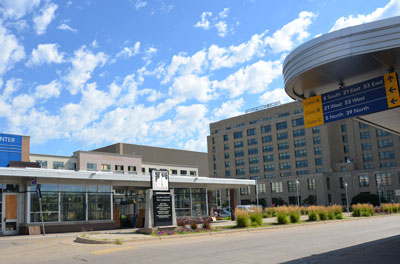Mobility Hub Planning Guide
 Today, we have many more ways to get around than ever. Whether you use transit, bike or scooter share, car share, or ride-hail services, a mobility hub is a place to make connections from one transportation choice to another.
Today, we have many more ways to get around than ever. Whether you use transit, bike or scooter share, car share, or ride-hail services, a mobility hub is a place to make connections from one transportation choice to another.
Everyone who uses a mobility hub should find a safe, comfortable, and accessible environment that creates a welcoming and positive experience. It’s a public space that should reflect the neighboring community and be designed for the people using it.
The Metropolitan Council and Metro Transit are creating a planning guide for local and regional stakeholders involved in developing mobility hubs. This project is the first step to support local entities to plan and implement mobility hubs that will help people easily switch between travel options and fill the gaps between different types of travel.
Project goal
The guide will encourage a strategic and coordinated system of mobility hubs that support investments in multimodal infrastructure.
The project will document the various mobility hub design and implementation options and provide specific guidance for both regional and local stakeholders as they plan, design, implement, and manage mobility hubs.
It will also deliver an analysis of local land use and transportation contexts where mobility hubs are best supported. Finally, the guide will also include recommended hub locations based on existing transportation services, land use, demographics and other factors to highlight areas that could benefit the most from mobility hubs investments.
Project timeline
Phase 1 — Discovery and direction: February to April 2021
Phase 2 — Methods and analysis: May to July 2021
Phase 3 — Guidance and tools: June to December 2021
Phase 4 — Stakeholder review and publication: January to June 2022
Outcomes
Mobility Hub Planning and Implementation Guidebook
The planning guide is a tool for local and regional stakeholders to assist in developing mobility hubs. The guide is broken into three modules so readers can start reading wherever they are in the hub planning process.
- Overview of what mobility hubs are, and the vision and objectives for hubs (page 7)
- Common problems mobility hubs can help solve (page 19)
- Eight basic questions to ask when planning for a hub (page 23)
- Case studies of who is getting mobility hubs right (page 30)
- How to center equity in planning for hubs (page 38)
- Sample performance measures (page 46)
- Summary of the four elements of hubs and their application based on land use (page 51). Contains use cases, how to site and implement hub elements, and any special considerations.
- Mobility Elements (page 55) – Guide to designing with different modes like bikeshare, scootershare, microtransit
- Technology and Information (page 62) – Guide to designing with different technology systems like smart parking, EV charging, parcel and delivery lockers
- Place Based Amenities and Cultural Assets (page 68) – Guide to incorporating elements that create a sense of place like vendors, lighting/seating, and heat
- Foundational Demand Management Strategies (page 70) – Guide to implementing travel demand management strategies like parking management, incentives, policies, and education
- Vehicle miles traveled reduction potential by mode (page 75)
- Building and Siting the Mobility Mix (page 78) – Determine where to site your hub based on your land use context. Includes key characteristics of these hubs, mode matching/decision tool, and effective strategies
- Urban Core Hubs (page 82)
- Suburban District Hubs (page 88)
- Edge Hubs (page 90)
- Activity Hubs (page 92)
- Provides an overview of different pathways to implementation and potential partners/stakeholders to involve (page 102)
- Pathway 1: Retrofit an existing location (page 104)
- Pathway 2: Pilot and demonstrate new features (page 105)
- Pathway 3: Encode hub enhancements (page 106)
- Pathway 4: Integrate into projects and developments (page 107)
- Pathway 5: Leverage partners for build out (page 108)
- Establish Management and Operational Plans to Ensure Resiliency – how to maintain and operate hubs
- Potential Challenges and Interjurisdictional Coordination (page 110)
- General Maintenance (page 112)
- Leveraging Partnership Opportunities (page 114)
List of regional mobility hubs
As part of the planning process, the stakeholder group supported a GIS analysis to identify key regionally significant mobility hubs across the region. From 400+ potential locations, the maps identifies 50 regionally significant hubs that will help achieve regional goals identified in the Transportation Policy Plan.
Engagement
The Met Council conducted a public survey about travel behaviors in April and May 2021 as part of the public outreach process for the Mobility Hub Planning Guide. Review the Mobility Hub Survey Analysis Results – High-Level Findings (PDF).
Project stakeholders
- Capitol Area Architectural and Planning Board
- City of Maple Grove
- City of Maplewood
- City of Minneapolis
- City of St. Paul
- City of Woodbury
- Hennepin County
- HOURCAR
- Minnesota Council on Disability
- Minnesota Department of Transportation
- Move Minnesota
- Musicant Group
- Minnesota Valley Transit Authority
- Nice Ride MN
- Plymouth Metro Link
- Ramsey County
- Scott and Carver Counties
- SouthWest Transit
- University of Minnesota Humphrey School of Public Affairs
- Washington County